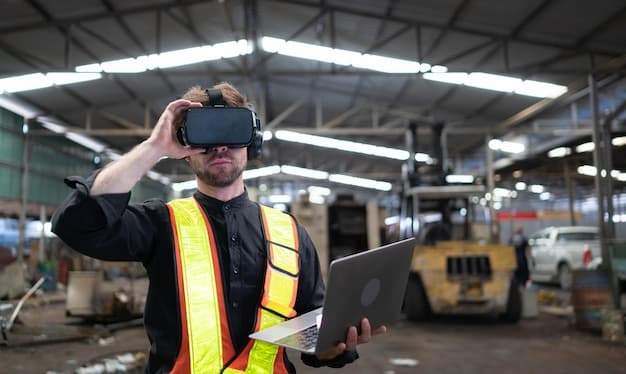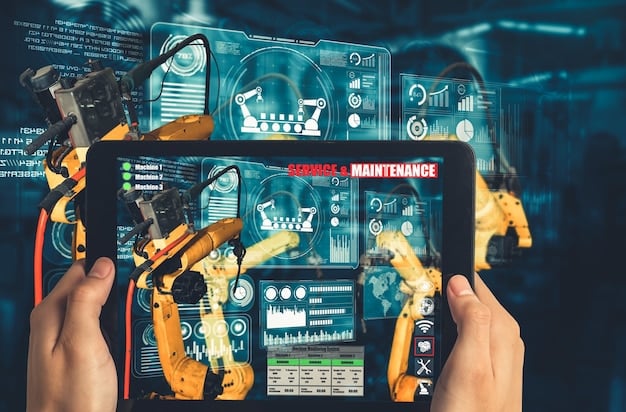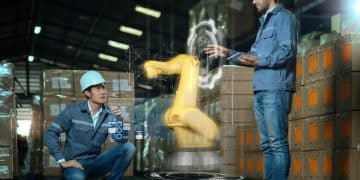Augmented Reality in Manufacturing: Boosting Productivity & Reducing Errors

Augmented reality in manufacturing integrates digital information with the physical world, offering real-time guidance and data visualization that significantly enhances worker productivity and dramatically reduces errors across various industrial processes.
The manufacturing landscape is undergoing a profound transformation, driven by technological advancements that are reshaping how products are made and how workers interact with complex systems. Among these innovations, augmented reality in manufacturing: how can AR enhance worker productivity and reduce errors? emerges as a particularly powerful force, offering solutions that bridge the gap between digital data and physical tasks. This technology isn’t just a futuristic concept; it’s a practical tool actively being implemented to refine industrial processes, improve human performance, and create more efficient, safer working environments.
Understanding Augmented Reality in an Industrial Context
The integration of augmented reality (AR) within manufacturing environments represents a significant paradigm shift, offering tangible improvements in operational efficiency and worker capabilities. Unlike virtual reality, which immerses users in completely simulated worlds, AR overlays digital information onto the real-world view, allowing workers to interact with virtual data and objects in their physical surroundings. This provides immediate, context-aware information, crucial for fast-paced and error-sensitive production lines.
AR’s industrial applications are vast, ranging from complex assembly guidance to remote assistance and quality control. Imagine a technician performing intricate repairs; instead of consulting cumbersome manuals, AR glasses display step-by-step instructions directly onto the equipment, highlighting components and providing real-time data. This immediate access to information minimizes guesswork and increases the speed and accuracy of tasks, transforming the traditional manufacturing workflow into a more dynamic and interactive experience.
How AR Enhances Worker Productivity
Augmented reality directly impacts worker productivity by streamlining processes and providing immediate access to critical information. This technology equips workers with tools that diminish cognitive load and reduce the time spent on non-productive tasks, allowing them to focus more intensely on the work at hand. The result is a more efficient and capable workforce, less prone to the delays caused by information retrieval or complex problem-solving without adequate support. AR transforms static instructions into dynamic, contextual guidance.
- Reduced Training Time: AR offers immersive, hands-on training simulations where new employees can learn complex tasks in a safe, guided environment. This accelerates skill acquisition and reduces the need for extensive, often costly, traditional training programs.
- Improved Assembly Speed: Workers receive real-time, step-by-step instructions overlaid directly onto the product or machinery, eliminating the need to consult separate manuals or screens. This leads to faster and more accurate assembly.
- Enhanced Maintenance & Repair: Technicians can visualize schematics, repair procedures, and diagnostic data directly on the equipment they are working on, significantly cutting down troubleshooting and repair times.
- Streamlined Workflow: By integrating digital information into the physical workspace, AR reduces interruptions and cognitive burden, allowing workers to maintain focus and execute tasks with greater fluidity.
Minimizing Errors with AR Integration
The capacity of augmented reality to drastically reduce errors in manufacturing environments is one of its most compelling benefits. By providing instant, precise, and visual guidance, AR effectively minimizes the likelihood of human mistakes that often lead to rework, scrap, or even safety incidents. This direct intervention through digital overlays helps workers confirm correct procedures and identify potential deviations before they escalate into costly errors.
AR systems act as a vigilant digital assistant, cross-referencing completed steps with required specifications, alerting workers to missed steps or incorrect component selections. This proactive error prevention mechanism enhances the overall quality output and ensures compliance with rigorous production standards. The immediate feedback loop and predictive guidance offered by AR contribute significantly to a manufacturing process that is not only faster but also inherently more reliable. Early detection and prevention of errors are crucial.
By reducing errors, AR not only saves material and time but also contributes to a safer working environment. Mishaps often stem from misinterpretations or procedural mistakes, and AR’s clear, unambiguous instructions help to mitigate these risks. The result is a more robust, quality-driven production process that impacts the bottom line and elevates operational safety standards.
Key Applications of AR in Modern Manufacturing
Augmented reality isn’t a one-size-fits-all solution, but a versatile technology with tailored applications across various manufacturing functions. Its ability to overlay digital information onto the real world makes it uniquely suited for enhancing precision, speed, and safety in complex industrial settings. From initial design to final inspection, AR tools are integrating seamlessly into workflows, delivering tangible benefits and transforming traditional practices. The impact stems from the immediate and contextual delivery of information.
The diverse applications of AR highlight its adaptability and potential to revolutionize discrete aspects of the manufacturing lifecycle. Each application addresses specific challenges within the production chain, contributing to an overall more efficient and less error-prone operational environment. Manufacturers are increasingly recognizing AR as not just a luxury, but a strategic investment for future competitiveness.
Assembly and Production Guidance
One of the most immediate and impactful applications of AR in manufacturing is in providing real-time assembly and production guidance. Workers can wear AR smart glasses that display digital overlays directly onto workpieces, guiding them through complex assembly sequences, bolt tightening patterns, or wiring diagrams. This eliminates the constant need to consult physical manuals or CAD drawings, which can be time-consuming and prone to misinterpretation. The visual cues ensure that each step is executed correctly and in the proper sequence, significantly reducing the chances of common assembly errors. This helps to standardize quality across different shifts and experience levels.
In lean manufacturing environments, minimizing waste and maximizing throughput are paramount. AR contributes to these goals by providing immediate visual confirmation of correct part selection and placement. For instance, an AR system can highlight the exact bin from which to pick a component or indicate the precise location where a part needs to be installed, preventing the use of incorrect parts or improper assembly. This proactive error-proofing is essential for maintaining high production quality and avoiding costly rework or recalls. The real-time visual feedback loop embedded in AR systems is invaluable for maintaining precision.
Quality Control and Inspection
Augmented reality is revolutionizing quality control and inspection processes by empowering technicians with immediate, precise diagnostic tools. Instead of relying solely on manual measurements or static checklists, AR allows inspectors to overlay digital blueprints, tolerance specifications, and defect detection algorithms directly onto physical components. This provides an instant visual comparison, highlighting any deviations from design, enabling quicker identification of flaws, and ensuring products meet stringent quality standards. This dramatically reduces the potential for human oversight and improves the consistency of inspections.
For example, an AR headset can highlight areas of a product that require closer inspection, or overlay a thermal map to identify potential overheating issues in an electronic component. This augmented visual feedback ensures that no detail is missed, leading to higher product reliability and fewer warranty claims. The ability of AR to log and document inspection results digitally during the process also streamlines compliance and traceability, making quality assurance more robust and efficient within the manufacturing flow.
Maintenance and Repair Operations
AR significantly enhances maintenance and repair (MRO) operations by transforming how technicians access and interpret critical information. Through AR devices, maintenance personnel can view digital schematics, step-by-step repair guides, and real-time operational data directly overlaid onto the machinery they are servicing. This immediate, contextual information helps in quickly diagnosing issues, performing complex repairs, and verifying correct reassembly, minimizing equipment downtime. The visual guidance bypasses the need for physical manuals or external screens, speeding up response times.
- Remote Expert Assistance: AR allows field technicians to connect with remote experts who can see what the technician sees and provide real-time visual annotations and guidance, even from thousands of miles away. This reduces the need for expert travel and accelerates problem resolution.
- Preventive Maintenance Prompts: AR systems can be integrated with IoT sensors to provide real-time alerts about equipment anomalies. Technicians can then use AR to visualize sensor data overlaid on the equipment, helping them identify and address potential failures before they occur.
- Safety Compliance: AR can display critical safety information, such as lockout/tag-out procedures or hazardous zone warnings, directly in the technician’s field of view, helping to prevent accidents during maintenance activities.
Design and Prototyping Visualization
While often associated with production, AR also offers immense value in the early stages of manufacturing—design and prototyping. Designers and engineers can use AR to overlay 3D CAD models onto physical spaces, allowing them to visualize new product designs or factory layouts in a real-world context before committing to expensive physical prototypes. This capability facilitates iterative design improvements and helps identify potential ergonomic issues or spatial conflicts early in the development cycle, reducing costly redesigns later. This allows for rapid validation of design concepts.
For instance, an automotive engineer might use AR to project a new car engine design onto an existing chassis, immediately seeing how components fit and interact. This real-time visualization helps in detecting interferences or optimizing component placement, accelerating the design review process. By bridging the gap between digital models and physical reality, AR empowers teams to collaborate more effectively and make more informed decisions during the critical design and prototyping phases.
Employee Training and Upskilling
Augmented reality is proving to be a game-changer in employee training and upskilling within manufacturing. Traditional training methods, which often involve classroom lectures or shadowing experienced workers, can be time-consuming and less effective for complex manual tasks. AR provides an immersive, hands-on learning experience where new hires can practice procedures in a safe, controlled environment with immediate visual feedback. This accelerates the learning curve and builds practical confidence.
Through AR headsets, trainees can get step-by-step holographic instructions overlaid onto real equipment. This could be anything from learning the proper sequence for assembling a complex machine to understanding the safety protocols for operating hazardous machinery. The ability to repeat procedures virtually, without consuming raw materials or risking equipment damage, makes training more efficient and cost-effective. Furthermore, AR can dynamically adapt training modules based on a learner’s progress, providing personalized instruction and boosting skill acquisition.

Challenges and Considerations for AR Implementation
While the benefits of augmented reality in manufacturing are compelling, successful implementation is not without its challenges. Adopting new technologies requires careful planning, significant investment, and an understanding of the potential hurdles. Overcoming these obstacles is crucial for realizing AR’s full potential and ensuring a smooth transition into a more augmented operational environment. Addressing these issues proactively can significantly improve deployment success rates.
The challenges in AR adoption extend beyond mere technical integration; they involve human factors, data management, and the overall strategic alignment of the technology with business goals. A comprehensive approach that considers all these dimensions is essential for navigating the complexities of AR deployment and maximizing its return on investment.
Initial Investment and ROI
The capital outlay for implementing augmented reality solutions in manufacturing can be substantial. This includes the cost of specialized hardware, such as industrial-grade AR headsets, smart glasses, and tablets, as well as the software platforms required for content creation, management, and deployment. Beyond the hardware and software, there are often significant costs associated with custom application development, integration with existing enterprise systems (like MES or ERP), and ongoing maintenance.
Quantifying the return on investment (ROI) for AR can also be complex. While the benefits like reduced errors, increased productivity, and faster training are clear, translating these into measurable financial gains requires careful tracking and analysis. Companies must establish clear key performance indicators (KPIs) before implementation to demonstrate the economic value of AR over time. Long-term gains often overshadow initial costs.
Data Security and Connectivity Concerns
Integrating augmented reality systems into existing manufacturing networks introduces new considerations for data security and network connectivity. AR applications often rely on real-time access to sensitive operational data, including CAD files, production schedules, and proprietary process information. Ensuring the secure transmission and storage of this data is paramount to prevent breaches and protect intellectual property. Robust encryption protocols, secure authentication methods, and stringent access controls are essential elements of any AR deployment strategy.
Furthermore, the performance of AR applications is highly dependent on reliable, low-latency connectivity. In large manufacturing facilities, ensuring ubiquitous and robust Wi-Fi or 5G coverage can be a significant challenge, especially in environments with heavy machinery or physical obstructions that can interfere with signals. Intermittent connectivity can lead to frustrating user experiences, hindering the real-time capabilities that make AR so valuable. A stable network infrastructure is non-negotiable for consistent operation and an overall positive user experience.
User Acceptance and Training
Even the most advanced technology can fail if not embraced by its end-users. User acceptance is a critical factor in the successful adoption of augmented reality in manufacturing. Employees accustomed to traditional methods may initially be resistant to wearing AR devices or learning new interaction paradigms. Issues such as discomfort from wearing headsets for extended periods, technical glitches, or a steep learning curve can lead to low adoption rates. Addressing these human factors is as important as technical implementation.
Effective training programs are crucial to overcome initial resistance and ensure that workers are proficient in using AR tools. This training should go beyond simply showing how to operate the device; it should emphasize the benefits of AR for the individual worker, demonstrating how the technology makes their jobs easier, safer, and more efficient. Providing clear instructions, hands-on practice, and ongoing support can significantly improve user confidence and accelerate the integration of AR into daily workflows. Ergonomics and ease of use are paramount for sustained adoption.
Integration with Existing Systems
A factory floor is rarely a blank slate; it’s typically a complex ecosystem of existing machinery, software systems, and data flows. Integrating new augmented reality solutions into this established infrastructure can present significant technical challenges. AR systems need to be able to pull data from and push data to a variety of Industrial Internet of Things (IIoT) sensors, Manufacturing Execution Systems (MES), Enterprise Resource Planning (ERP) databases, and Product Lifecycle Management (PLM) tools. Achieving seamless interoperability requires robust APIs and often custom development work.
Without proper integration, AR applications may operate in isolation, limiting their full potential. For example, an AR work instruction system might be less effective if it can’t automatically update based on real-time inventory levels from the MES or access the latest design revisions from the PLM system. Ensuring that data flows freely and accurately between AR and legacy systems is essential for providing workers with the most current and relevant information, transforming what might otherwise be a standalone tool into an integrated and powerful component of the smart factory.

The Future Landscape of AR in Manufacturing
The trajectory of augmented reality in manufacturing points towards an increasingly sophisticated and integrated role within the industrial ecosystem. As technology matures and adoption becomes more widespread, AR is poised to move beyond niche applications to become a foundational component of smart factories, driving unprecedented levels of efficiency, intelligence, and human-machine collaboration. The future scope will encompass deeper integration and more intuitive interfaces, further diminishing the line between the digital and physical.
Anticipate AR experiences to become more personalized, dynamic, and intuitive. Advancements in artificial intelligence and machine learning will enable AR systems to not only provide static instructions but also to adapt guidance based on worker performance, environmental conditions, and real-time operational data. This predictive and adaptive capability will further elevate human potential within manufacturing.
Advancements in Hardware and Software
The continuous evolution of augmented reality hardware and software will significantly shape its future in manufacturing. Hardware is becoming lighter, more comfortable, and more powerful, with improved battery life and display resolution. This will lead to wider adoption by reducing user fatigue and improving the clarity of overlaid information. Next-generation AR glasses are expected to feature wider fields of view, better depth sensing, and more robust designs suitable for harsh industrial environments, moving closer to the ideal of unobtrusive, daily-wear devices.
On the software front, advancements in AI, machine learning, and computer vision will empower AR applications with greater intelligence. Future AR systems will be able to perform real-time object recognition, anticipate worker needs, and even offer predictive analytics. Cloud-based AR platforms will enable easier content creation, deployment, and management across multiple factory sites. The integration of advanced haptics and more natural user interfaces—such as gesture control and voice commands—will make AR interactions even more intuitive, further enhancing worker experience and efficiency.
Integration with Industry 4.0 and Smart Factories
Augmented reality is a key enabler for Industry 4.0 and an essential component of the smart factory concept. Its future in manufacturing is intertwined with the broader trend of digital transformation, where physical and digital systems converge to create highly efficient and adaptive production environments. AR will serve as the primary human interface that connects workers to the vast amounts of data generated by IoT sensors, AI analytics, and other smart factory systems. This integration will create a seamlessly intelligent ecosystem.
In a smart factory, AR will not just provide instructions; it will contextualize data from throughout the production chain, offering workers a real-time, holistic view of operations. Imagine an AR system displaying the performance metrics of a specific machine, alerting a supervisor to potential bottlenecks, or showing a quality inspector the historical defect rates of a batch—all overlaid onto the physical environment. This real-time, contextual data delivery will unlock unprecedented levels of operational transparency, predictive maintenance, and adaptive manufacturing, solidifying AR’s role as a cornerstone of the next industrial revolution.
| Key Aspect | Brief Description |
|---|---|
| ⚙️ Productivity Boost | AR offers real-time guidance, reducing training time and accelerating complex assembly and maintenance tasks. |
| ❌ Error Reduction | Visual overlays and immediate feedback loops minimize human errors in production, assembly, and quality control. |
| 💡 Key Applications | Includes assembly guidance, quality inspection, maintenance, design visualization, and employee training. |
| 🚧 Implementation Hurdles | Challenges involve initial investment, data security, user adoption rates, and integration with legacy systems. |
Frequently Asked Questions About AR in Manufacturing
▼
Augmented reality (AR) in manufacturing overlays digital information, such as instructions, 3D models, or performance data, onto a worker’s real-world view, typically via smart glasses or tablets. This allows for real-time, context-aware visual guidance and interaction, enhancing efficiency and accuracy across various production processes without completely blocking the real world.
▼
AR boosts productivity by providing workers with instant, hands-free access to critical information and step-by-step guidance. This reduces time spent consulting manuals, speeds up assembly and maintenance tasks, and minimizes errors, leading to quicker task completion and higher output. It also shortens training times for new employees, getting them to proficiency faster.
▼
Yes, AR is highly effective in reducing manufacturing errors. By overlaying precise digital instructions, highlighting correct components, and indicating proper tool usage, AR systems act as an immediate error-proofing mechanism. Workers receive real-time feedback, preventing incorrect procedures or part selections, which dramatically lowers rework rates, scrap, and quality control issues.
▼
Common AR applications include real-time assembly guidance, where instructions are overlaid on products; quality control and inspection, allowing visual comparison with digital blueprints; maintenance and repair, providing interactive schematics; remote expert assistance for troubleshooting; and immersive training for new hires. It streamlines complex, manual tasks efficiently.
▼
Key challenges include the significant initial investment in hardware and software, ensuring robust data security and reliable network connectivity across the factory floor, and overcoming user acceptance by addressing comfort and training needs. Additionally, seamless integration with existing legacy systems (like ERP or MES) can be complex but is crucial for maximizing AR’s benefits.
Conclusion
The integration of augmented reality into manufacturing is no longer a futuristic concept but a tangible, transformative force. By delivering real-time, contextual information directly into the worker’s field of vision, AR remarkably enhances productivity, significantly reduces errors, and streamlines processes across the entire production lifecycle. While challenges associated with investment, integration, and user adoption persist, the undeniable benefits—ranging from accelerated training to improved quality control and safer operations—underscore AR’s critical role in the evolving landscape of Industry 4.0. As the technology continues to advance, augmented reality is poised to become an indispensable tool, empowering the workforce and driving the efficiency and intelligence of the next generation of factories.





